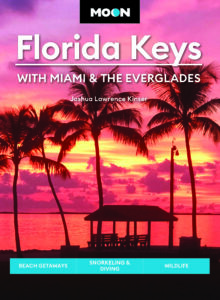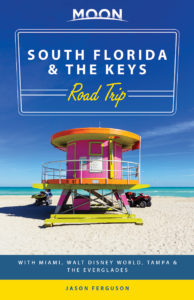Miami
Equal parts jet-set glitz and multicultural grit, and with more than half its population coming here from other countries, Miami (pop. 470,914; metro pop. 6.2 million) embodies the transitive state of the nation in the 21st century. Having sprung up from swampland in the 1920s, Miami has weathered hurricanes and race riots, real estate booms and busts, drug running, and endless political intrigue to become one of America’s most energetic cities. In her book Miami, Joan Didion describes the city as a place where it’s possible “to pass from walled enclaves to utter desolation while changing stations on the car radio.”
Approaching from Miami Beach past the cruise ship docks along the MacArthur Causeway, or the older and more leisurely Venetian Causeway, you experience the view of Miami made famous by the 1980s television series Miami Vice—downtown towers rising above Biscayne Bay. West of downtown, Miami’s most engaging district is Little Havana, which focuses along SW 8th Street (a.k.a. Calle Ocho) between 12th and 16th Avenues. Since the 1950s and 1960s, when refugees fleeing Fidel Castro’s communist regime fetched up here, this neighborhood has been the heart of Cuban-American Miami. Hang out for a while with the old men who congregate in the Domino Park on 8th Street at 15th Avenue, or visit the Martyrs of Giron (a.k.a. Bay of Pigs) Monument along 8th Street at 13th Avenue; you’ll definitely get a feel for it.
Better yet, stop for something to eat or drink at one of Little Havana’s many great Cuban cafés, like Versailles (3555 SW 8th St., 305/444-0240), a favorite haunt of Miami’s politically potent anti-Castro Cuban-Americans. Enjoy good traditional Cuban food: toasted chorizo sandwiches, or perhaps a bowl of ropa vieja (tender threads of garlicky beef in a black bean soup), finished off with a creamy flan and a cup of super-strong Cuban coffee. Between US-1 and I-95 on the intriguingly edgy and increasingly arty north side of downtown Miami, an informal outdoor graffiti museum called “Wynwood Walls” covers the warehouses around the Latin-themed Wynwood Kitchen and Bar (2550 NW 2nd Ave., 305/722-8959).
For an entirely different aspect of Miami, check out the two-time wild card World Series champion Miami Marlins (305/480-1300), who play at a retractably roofed $700 million stadium on the site of the historic Orange Bowl.
Miami Beach has the best range of stylish hotels, but in downtown Miami the top end of the style and expense spectrum is the Four Seasons (1435 Brickell Ave., 305/358-3535, $295 and up), offering stunning views from a 70-story tower. Back down to earth, the major chains all have locations on the downtown waterfront; as at all South Florida accommodations, room rates tend to increase considerably during the peak season (Dec.-Apr.).
Across Miami
The I-95 freeway and the old main route, US-1, both enter Miami north of downtown in the rough but quickly changing Little Haiti neighborhood, while the infinitely more scenic Hwy-A1A crosses Biscayne Bay from Miami Beach. Around downtown, Biscayne Boulevard winds along the waterfront, merging into historic Brickell Avenue, now lined by flashy postmodern bank and condo towers. From here, detour west on the one-way system along 7th and 8th Streets through Little Havana, then south through Coral Gables, joining the old Dixie Highway (US-1) for the drive south through Homestead to the Florida Keys.
Related Travel Map

















